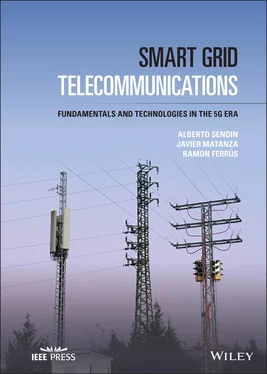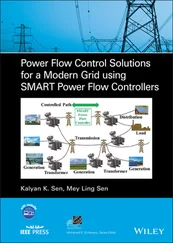Ramon Ferrús - Smart Grid Telecommunications
Здесь есть возможность читать онлайн «Ramon Ferrús - Smart Grid Telecommunications» — ознакомительный отрывок электронной книги совершенно бесплатно, а после прочтения отрывка купить полную версию. В некоторых случаях можно слушать аудио, скачать через торрент в формате fb2 и присутствует краткое содержание. Жанр: unrecognised, на английском языке. Описание произведения, (предисловие) а так же отзывы посетителей доступны на портале библиотеки ЛибКат.
- Название:Smart Grid Telecommunications
- Автор:
- Жанр:
- Год:неизвестен
- ISBN:нет данных
- Рейтинг книги:3 / 5. Голосов: 1
-
Избранное:Добавить в избранное
- Отзывы:
-
Ваша оценка:
- 60
- 1
- 2
- 3
- 4
- 5
Smart Grid Telecommunications: краткое содержание, описание и аннотация
Предлагаем к чтению аннотацию, описание, краткое содержание или предисловие (зависит от того, что написал сам автор книги «Smart Grid Telecommunications»). Если вы не нашли необходимую информацию о книге — напишите в комментариях, мы постараемся отыскать её.
Discover the foundations and main applications of telecommunications to smart grids Smart Grid Telecommunications,
Smart Grid Telecommunications
Smart Grid Telecommunications — читать онлайн ознакомительный отрывок
Ниже представлен текст книги, разбитый по страницам. Система сохранения места последней прочитанной страницы, позволяет с удобством читать онлайн бесплатно книгу «Smart Grid Telecommunications», без необходимости каждый раз заново искать на чём Вы остановились. Поставьте закладку, и сможете в любой момент перейти на страницу, на которой закончили чтение.
Интервал:
Закладка:
The challenge of telecommunications connectivity is to grow today's utilities' existing telecommunication networks by possibly several orders of magnitude and in very diverse circumstances. Until the advent of the Smart Grid, telecommunications connectivity needs in utilities were limited to some of their assets. As new elements are brought to the grid, changing the way the grid must be operated, a pervasive control and monitoring is needed, and telecommunications connectivity becomes a bottleneck, and eventually the weak‐link of all the Smart Grid strategy. Due to their varied nature, location, and requirements of the Smart Grid assets, telecommunications connectivity for their Smart Grid services will not be systematically and cost‐effectively provided over one single technology. The telecommunication network solution will be a hybrid one, combination of a mix of private and public/commercial telecommunication solutions. The optimal blend will be different for each utility due to historical, economical, technical, market, or strategic reasons [34].
The history of utilities cannot be understood without the telecommunication networks and services supporting their operations. The future of utilities with Smart Grid will reinforce this reality.
1.5 Challenges of the Smart Grid in Connection with Telecommunications
There are some Smart Grid challenges tightly connected to the use of telecommunications technologies and services. They can be grouped in two broad categories Customer Engagement and Grid Control .
1.5.1 Customer Engagement Challenges
The Consumption Point is now transformed into a customer, with changing needs and capabilities, in contrast to its view as a plain electricity service subscriber. It is important not only that, as a customer, it demands a quality service but also that the customer has a potential to contribute to the electric power system in various forms.
1.5.1.1 Customers as Smart Electricity Consumers
The customer is the entity driving the consumption patterns and electricity demands that, when aggregated across all the different types of customers (residential, industrial, etc.), define the power system load curve (see Figure 1.7).
The major concern of electric power system operators, apart from the hourly consumption prediction to manage generation sources in real time, is the general reduction of the curve peaks, and the possibility to control the load (consumption) at the moments where the system may not be prepared to cope with it.
If the consumption pattern can be influenced, the total electricity demand can be flattened, while keeping total energy consumed the same. This effect implies that the system does not need to be dimensioned to cope with the worst‐case condition of electricity demand. On the other hand, the system operator needs to have tools available to control the loads present in the network (i.e., to be capable of reducing the number of them connected or, to curtail their consumption) in a near‐real‐time manner.
The customer needs to be convinced of taking a more active role to yield part of his freedom to consume to the system operator (for a certain incentive), for the system to be optimized. To favor such involvement, customers need to be aware of the offered possibilities, and this is when they need to perceive the usefulness of their contribution and need to have easy‐to‐use access to the mechanism that enable this participation in the system. Customers will then only be convinced if they are able to easily see the result of their effort, and, if this effort is not cumbersome and facilitated by the utility through the use of processes and tools.

Figure 1.7 Sample weekly aggregated electricity demand curve. Consumption in the Spanish peninsula.
Source: Real‐time Spanish Electricity Demand [38].
DSM is the key concept to get the customer to participate in the electric power system. DSM includes all the activities performed by the utilities to “influence” the customer demand to balance instantaneous grid electricity supply with the demand. DSM groups together a set of activities including pure energy efficiency initiatives, where Demand Response (DR) is the most important one (see Chapter 5).
1.5.1.2 Customers as Energy Generators
Customers have now a set of technologies (DER [39]) that allow them to participate as an agent that has the possibility of producing part of the energy they need, and even help the grid, making any excess of generation available for the system.
There are multiple DER elements, including DG but also Energy Storage (ES), and not forgetting Electric Vehicles (EVs), that play a role for the system (positive, as “batteries on wheels”; challenging, as “moving loads”) further than their direct environmental impact (reduction in fossil energy sources consumption).
DG includes wind power, solar power, geothermal power, biomass, and fuel cells. They can be manageable or unmanageable from the grid perspective, depending on several factors such as their installed capacity, the availability of the energy they produce, and the connectivity and intelligence of their ancillary elements for grid integration. Notwithstanding, when these elements are available and connected at end‐user premises of small producers and communities, the consumer has the dual role of consumer and producer (i.e., a prosumer). However, the overall traditional concept of the energy power system protection and control needs to adapt to this new reality.
EVs, on their side, have a very interesting role to play. EVs contribute to the overall energy waste reduction, system efficiency, and fossil fuels and emission reduction and are seen as moving batteries to help the system. This can be done by means of the storage of certain types of energy produced at times where the consumption cannot take advantage of them [40] and be used to charge EVs and have it delivered when and where it is needed.
1.5.2 Grid Control Challenges
Within the Transmission segment, challenges are those inherent to its role in the system. Despite the evolution of the electric power system technologies, Transmission has not been affected by technical disruptions that impose a new reinvention of its nature. However, their traditional functions can be pretty much enhanced.
The need to keep energy loss at a minimum justifies the need to understand and control the different power line parameters involved in ampacity (i.e., maximum value of electric current – Amperes) calculations. Grid stability is another concept of great importance, as the connection of bulk‐generation at different parts of the network can cause instability if the voltage phase difference between the power signals is too different at the two ends of the line. Last but not least, harmonics of the fundamental frequency (50 or 60 Hz) have to be controlled, as they would be propagated along the grid, impacting overall quality of the electricity wave.
There are other needs related with the physical aspects of the cables, leading to keep the infrastructure available and extending its useful life [41]. There is a growing need to easily detect the origin of faults in the power lines and be able to identify and communicate its exact location. These needs can be supported with modern telecommunications‐related technology. These technologies can also help to control strain in the cables when they are being laid out, specifically in cables under special conditions (e.g., submarine routes).
Читать дальшеИнтервал:
Закладка:
Похожие книги на «Smart Grid Telecommunications»
Представляем Вашему вниманию похожие книги на «Smart Grid Telecommunications» списком для выбора. Мы отобрали схожую по названию и смыслу литературу в надежде предоставить читателям больше вариантов отыскать новые, интересные, ещё непрочитанные произведения.
Обсуждение, отзывы о книге «Smart Grid Telecommunications» и просто собственные мнения читателей. Оставьте ваши комментарии, напишите, что Вы думаете о произведении, его смысле или главных героях. Укажите что конкретно понравилось, а что нет, и почему Вы так считаете.












